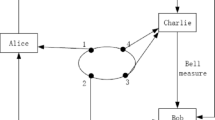Abstract
In this paper, we propose a new electronic voting scheme using Bell entangled states as quantum channels. This scheme is based on quantum proxy signature. The voter Alice, vote management center Bob, teller Charlie and scrutineer Diana only perform single particle measurement to realize the electronic voting process. So the scheme reduces the technical difficulty and increases operation efficiency. It can be easily realized. We use quantum key distribution and one-time pad to guarantee its unconditional security. The scheme uses the physical characteristics of quantum mechanics to guarantee its anonymity, verifiability, unforgetability and undeniability.
Similar content being viewed by others
References
Ku, W., Wang, S.D.: Comput. Commun. 22(3), 279–286 (1999)
Jan, J.K., Tai, C.C.: J. Syst. Softw. 39(12), 93–101 (1997)
Fan, C.I., Lei, C.L.: Electron. Lett. 32(9), 811–813 (1996)
Shor, P.W., et al.: Phys. Rev. Lett 85(2), 441–444 (2000)
Barnum, H., Crepeau, C., Gottesman, D., Smith, A., Tapp, A.: Proceedings of the 43th Annual IEEE Symposium on Foundations of Computer Science, pp 449–470 (2002)
Zeng, G.H., Keitel, C.H.: Phys. Rev. A 65, 042312 (2002)
Lee, H., Hong, C.H., Kim, H., et al.: Phys. Rev. A 321(5–6), 295–300 (2002)
Wen, X.J., Liu, Y., Sun, Y.Z.: Natureforschung A 62, 147–151 (2007)
Wen, X.J., Liu, Y., Sun, Y.: Chin. J. Electron. 17, 340–344 (2008)
Li, Q., Chan, W.H., Long, D.Y.: Phys. Rev. A 79, 054307 (2009)
Wu, Y.H., Zhai, W.D., Cao, W.Z., et al.: Int. J. Theor. Phys. 50(7), 325–331 (2011)
Yin, X.R., Ma, W.P., Liu, W.Y.: Int. J. Quanum. Inform. 10, 1250041 (2012)
Becerra, F.E., Fan, J., Migdall, A.: Nat. Commun. 4, 2028 (2013)
Cao, H.J, Huang, J., Yu, Y.F., Jiang, X.L.: Int. J. Theor. Phys. 539, 3095–3100 (2014)
Wang, M.L., Ma, W.P., Wang, L.L., Yin, X.R.: Mod. Phys. Lett. B 29 (28), 1550173 (2015)
Buhrman, H., Cleve, R., Watrous, J., et al.: Phys. Rev. A 87, 167902–167904 (2011)
Lo, H.K., Chau, H.F.: Science 283, 2050 (1999)
Mayers, D.: J. ACM 48(3), 351–406 (2001)
Lo, H.K.: J. Phys. A: Math. Gen. 34, 6957 (2001)
Author information
Authors and Affiliations
Corresponding author
Ethics declarations
Conflict of interest
The authors declare that we have no conflict of interest.
Additional information
Project supported by the National Natural Science Foundation of China(Grant No 11305100)
Rights and permissions
About this article
Cite this article
Cao, HJ., Ding, LY., Yu, YF. et al. A Electronic Voting Scheme Achieved by Using Quantum Proxy Signature. Int J Theor Phys 55, 4081–4088 (2016). https://doi.org/10.1007/s10773-016-3036-5
Received:
Accepted:
Published:
Issue Date:
DOI: https://doi.org/10.1007/s10773-016-3036-5




